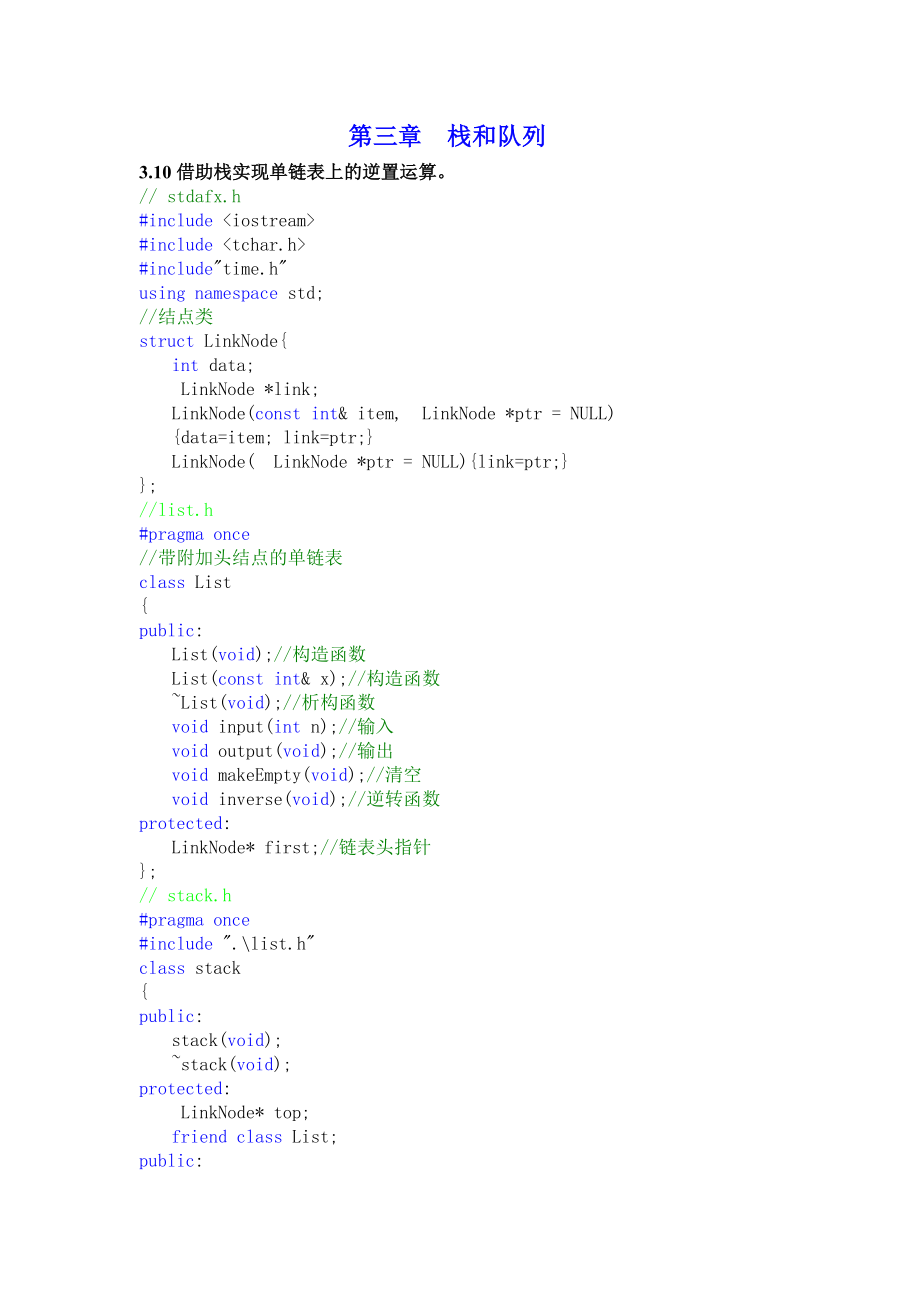 数据结构第三章到第九章练习题答案
数据结构第三章到第九章练习题答案



《数据结构第三章到第九章练习题答案》由会员分享,可在线阅读,更多相关《数据结构第三章到第九章练习题答案(34页珍藏版)》请在装配图网上搜索。
1、第三章 栈和队列3.10借助栈实现单链表上的逆置运算。/ stdafx.h #include #include #includetime.husing namespace std;/结点类struct LinkNodeint data; LinkNode *link;LinkNode(const int& item, LinkNode *ptr = NULL)data=item; link=ptr;LinkNode( LinkNode *ptr = NULL)link=ptr;/list.h#pragma once/带附加头结点的单链表class Listpublic:List(void);/
2、构造函数List(const int& x);/构造函数List(void);/析构函数void input(int n);/输入void output(void);/输出void makeEmpty(void);/清空void inverse(void);/逆转函数protected:LinkNode* first;/链表头指针;/ stack.h#pragma once#include .list.h class stackpublic:stack(void);stack(void);protected: LinkNode* top;friend class List;public:voi
3、d Push(const int& x);bool Pop();bool IsEmpty(void)return(top=NULL)?true:false;/ list.cpp#include StdAfx.h#include .list.h#using List:List(const int& x)first= new LinkNode(x);List:List(void)first= new LinkNode;List:List(void)makeEmpty();void List:input(int n)LinkNode * newNode;first=new LinkNode;for(
4、int i=0;ilink=first-link;first-link=newNode;void List:output(void)LinkNode *current=first-link;while(current!=NULL)coutdatalink;coutlink!=NULL)p=first-link;first-link=p-link;delete p;/逆转函数void List:inverse(void)stack s;LinkNode *p=first-link,*q;while(p!=NULL)s.Push(p-data);p=p-link;p=first-link;whil
5、e(!s.IsEmpty()q=s.top;p-data=q-data;p=p-link;s.Pop();/ Stack.cpp#include StdAfx.h#include .stack.h#using stack:stack(void): top(NULL) stack:stack(void)/入栈void stack:Push(const int& x)top=new LinkNode(x,top);/出栈bool stack:Pop()if(IsEmpty()=true) return false; LinkNode *p=top;top=top-link;delete p;ret
6、urn true;/Main.cpp#include stdafx.h#include .list.h#using using namespace System;int _tmain() srand(time(NULL); List l; /调用输入函数 l.input(10); /调用输出函数 l.output(); cout调用逆转函数endl; l.inverse(); /调用输出函数 l.output();return 0;3.12编写一个算法,将一个非负的十进制整数N转换为另一个基为B的B进制数。/ stdafx.h #include #include using namespace
7、 std;struct LinkNodeint data;LinkNode *link;LinkNode(const int& item, LinkNode *ptr = NULL)data=item; link=ptr;LinkNode( LinkNode *ptr = NULL)link=ptr;/stack.h#pragma onceclass stackpublic:stack(void);stack(void);void Push(const int& x);bool Pop(int& x);bool IsEmpty(void)return(top=NULL)?true:false;
8、protected:LinkNode* top;/stack.cpp#include StdAfx.h#include .stack.h#using stack:stack(void): top(NULL) stack:stack(void) void stack:Push(const int& x)top=new LinkNode(x,top);bool stack:Pop(int& x)if(IsEmpty()=true) return false; LinkNode *p=top;top=top-link;x=p-data;delete p;return true;/main.cpp#i
9、nclude stdafx.h#include .stack.h#using using namespace System;int _tmain() int n, m, temp,yu; coutn; coutm; stack l; while(n!=0 & m!=0) temp=n%m; n=n/m; l.Push(temp); while(!l.IsEmpty() l.Pop(yu); coutyu; coutendl;return 0;3.21试编写一个算法,求解最大公因数问题:在求两个正整数m和n的最大公因数常常使用辗转相除法,反复计算直到余数为零为止。其递归定义为:/ stdafx.
10、h #include #include #include using namespace std;int f(int n1,int n2);/main.cpp#include stdafx.h#using using namespace System; int _tmain() int n1,n2; coutEnter the first positive number: n1; coutEnter the second positive number: n2; if(n10 & n20) cout n1 和 n2 的最大公约数是: f( n1, n2) endl; else cout非法数据
11、endl;return 0;int f(int n1,int n2) int t;while(n2!=0) t= n1 % n2;n1= n2;n2= t; return n1;3.23假设以数组Qm存放循环队列中的元素,同时设置一个标志tag,以tag=0和tag=1来区别在对头指针(front)和对尾指针(rear)相等时,队列状态为“空”还是“满”。试编写与此结构相应的插入(EnQueue)和删除(DeQueue)算法。/ stdafx.h#include #include #includeusing namespace std;/SeqQueue.h#pragma onceclass
12、SeqQueuepublic:SeqQueue(int size=10);SeqQueue(void);protected:int rear,front,tag;int *element;int maxSize;public:bool EnQueue(const int& x);bool DeQueue(void);bool IsEmpty(void)return (front=rear & tag=0)?true:false;bool IsFull(void)return (front=rear & tag=1)?true:false;friend ostream& operator (os
13、tream& os,SeqQueue& Q);/SeqQueue.cpp#include StdAfx.h#include .SeqQueue.h#using SeqQueue:SeqQueue(int size):rear(0),front(0),tag(0),maxSize(size)element=new intmaxSize;SeqQueue:SeqQueue(void)delete element;bool SeqQueue:EnQueue(const int& x)if(IsFull()=true) return false;elementrear=x;rear=(rear+1)
14、% maxSize;tag=1;return true;bool SeqQueue:DeQueue(void)if(IsEmpty()=true) return false;front=(front+1) % maxSize;tag=0;return true;ostream& operator (ostream& os,SeqQueue& Q)int num;if(Q.front=Q.rear & Q.tag=1)num=Q.maxSize;elsenum=(Q.rear-Q.front+Q.maxSize)%Q.maxSize;for(int i=0;inum;i+)os(i+Q.fron
15、t)%Q.maxSize:Q.element(i+Q.front)%Q.maxSizet;return os;/main.cpp#include stdafx.h#include .SeqQueue.h#using using namespace System;int _tmain()srand(time(NULL); SeqQueue q;coutCall the EnQueue functionendl;for(int i=0;i9;i+)q.EnQueue(rand()%100);coutqendl;coutCall the DeQueue functionendl;q.DeQueue(
16、);q.DeQueue();coutqendl;return 0;第四章 数组、串与广义表4.12若矩阵Am*n中的某一元素Aij是第i行中的最小值,同时又是第j列中的最大值,则称此元素为该矩阵的一个鞍点。假设以二维数组存放矩阵,试编写一个函数,确定鞍点在数组中的位置(若鞍点存放在时),并分析该函数的时间复杂度。/ stdafx.h#include #include using namespace std;/main.cpp#include stdafx.h#include#using using namespace System;int _tmain() int A1010,rsize,ro
17、w,column,maxC,minD,max,min; srand(time(NULL); for(row=0;row10;row+) for (column=0;column10;column+) Arowcolumn=rand()%(100/(10-row)+100/(10-column); coutArowcolumnt; for(rsize=0;rsize10;rsize+) minD=0; min=Arsize0; for(column=1;columnArsizecolumn) minD=column; min=ArsizeminD; maxC=0; max=A0minD; for
18、(row=1;row10;row+) if(maxArowminD) maxC=row; max=ArowminD; if(max=min) coutArrayrsize+1minD+1是鞍点endl; return 0;时间复杂度分析:第二个for的嵌套循环是寻找鞍点的主要程序,假设数组Amn,则第一、二个内嵌循环时间代价分别为t1(n)=O(f(n)和 t2(m)=O(g(m),外循环的时间复杂度为t(m)=O(F(m)则整个程序段的时间复杂度为T= t(m)(t1(n)+ t2(m))因为for语句里if后面语句被执行的平均次数为(n-1)+(n-2)+1+0=n/2;所以f(n)=n/
19、2*2+n*3+2=n*4+2;则t1(n)=O(f(n)=O(n),同理得t2(m)=O(g(m)= O(m),而最后的if后面语句被执行的平均次数为(m +1)/2则T=O( (2+2+t1+2+t2+1)m+2+(m+1)/2)=O(maxmn , mm)4.13所谓回文,是指从前向后顺读和从后向前读都一样的不含空白字符的串。例如did,madamimadam,pop即是回文。试编写一个算法,以判断一个串是否是回文。/ stdafx.h#include #include #includeusing namespace std;/结点类#ifndef stdafx_h#define std
20、afx_htemplatestruct LinkNodeT data;LinkNode *link;LinkNode(const T& item, LinkNode *ptr = NULL)data=item; link=ptr;LinkNode( LinkNode *ptr = NULL)link=ptr;#endif/stack.h#pragma oncetemplateclass CCStackpublic:CCStack(void);CCStack(void);protected:LinkNode* top;public:void Push(const T& x);bool Pop()
21、;bool IsEmpty(void)return(top=NULL)?true:false;T getTop();/stack.cpp#include StdAfx.h#include .cstack.h#using templateCCStack:CCStack(void): top(NULL)templateCCStack:CCStack(void)templatevoid CCStack:Push(const T& x)top=new LinkNode(x,top);templatebool CCStack:Pop()if(IsEmpty()=true) return false; L
22、inkNode *p=top;top=top-link;delete p;return true;templateT CCStack:getTop()T x;if(IsEmpty()=true) return NULL;x=top-data;return x;/main.cpp#include stdafx.h#include .cstack.cpp#using using namespace System;int _tmain() string a;bool temp=true;int i=0;CCStack st;cina;while(ai!=0)st.Push(ai);i+;i=0;wh
23、ile(ai!=0)if(ai=st.getTop()st.Pop(); i+;elsetemp=false;break;if(temp)cout此字符是回文endl;elsecout此字符不是回文endl;return 0;4.15编写一个算法frequency,统计在一个输入字符串中各个不同字符出现的频度。用适当的测试数据来验证这个算法。/ stdafx.h #include #include #includeusing namespace std;/main.cpp#include stdafx.h#using using namespace System;int _tmain() st
24、ring a;int k,*num;char *A; cina; k=a.length();A = new chark;num = new intk;frequency(a, A, num,k=0 );for ( int i = 0; i k; i+ )coutAi:numi个endl;delete A;delete num;return 0;void frequency( string s, char A , int C , int &k ) int i, j, len = s.length( );A0 = s0; C0 = 1; /种类数k = 1; for ( i = 1; i len;
25、 i+ )Ci = 0;for ( i = 1; i len; i+ ) j = 0;while ( j k & Aj != si ) j+;if ( j = k ) Ak = si;Ck+;k+; else Cj+; 第五章 树5.2使用顺序表示和二叉链表表示法,分别画出图示二叉树的存储表示。答:1234567891 2 3 4 5 6 7 8 9 10 11 12 13 14 15 16 17 185.15写出向堆中加入数据4,2,5,8,3,6,10,14时,每加入一个数据后堆的变化。答:5.16判断以下序列是否是最小堆?如果不是,将它调整为:100,86,48,73,35,39,42,
26、57,66,21答:不是5.18已知一棵二叉树的前序遍历的结果是ABECDFGHIJ,中序遍历是EBCDAFHIGJ,试画出这颗二叉树。答:5.19给定权值集合15,03,14,02,06,09,16,17,构造相应的Huffman树,并计算它的带权外部路径长度。答:它的带权外部路径长度WPL=229第六章 集合与字典6.1设A=1,2,3,B=3,4,5,求下列结果:(1)A+B;(2)A*B;(3)A-B;(4)A.Contains(1);(5)A.AddMember(1);(6)A.DelMember(1);(7)A.Min()。答:(1)A+B=1,2,3,4,5(2)A*B=3(3)
27、A-B=1,2(4)A.Contains(1)=true(5)A.AddMember(1)=false,集合A不变(6)A.DelMember(1)=true,集合A=2,3(7)A.Min()=16.9设散列表为HT13,散列函数为H(key)=key%13,用闭散列法解决冲突,对下列关键码序列12,23,45,57,20,03,78,31,15,36造表。采用线性探查法寻找下一个空位,画出相应的散列表。答:Hash(12)=12 Hash(23)=10 Hash(45)=6 Hash(57)=5Hash(20)=7 Hash(3)=3 Hash(78)=0 Hash(31)=5Hash(1
28、5)=2 Hash(36)=100 1 2 3 4 5 6 7 8 9 10 11 1278153574520312336126.10设有150个记录要存储到散列表中,并利用线性探查法解决冲突,要求找到所需记录的平均比较次数不超过2次。试问散列表需要设计多大?(设a是散列表的装载因子,则有ASLsucc=(1+1/(1-a)/2)答:设散列表的长度为m;因为a=150/m,ASLsucc=(1+1/(1-a)/2且ASLsucc=2;所以得m=225第七章 搜索结构7.2设有序顺序表中的元素依次为017,094,154,170,275,503,509,512,553,612,677,765,8
29、97,908。试画出对其进行顺序搜索时的判定树。答:7.3设有序顺序表中的元素依次为017,094,154,170,275,503,509,512,553,612,677,765,897,908。试画出对其进行折半搜索时的判定树。答:8.1请给出该图的邻接矩阵,邻接表和逆邻接表。解:邻接矩阵:邻接表:逆邻接表:8.2对n个顶点的无向图和有向图,采用邻接矩阵和邻接表表示时,如何判断下列有关问题;(1)图中有多少条边?(2)任意两个顶点i和j是否有边相连?(3)任意一个顶点的度是多少?解:(1)用邻接矩阵表示无向图时,由于其为对称矩阵,所以统计矩阵的上三角或者下三角非零元素个数即为图的边数,用邻接
30、表表示时,邻接表中的边链表的边结点个数。除以2便是其边数。用邻接矩阵表示有向图时,矩阵的上非零个数即为其边数,用邻接表表示时,邻接表中的边链表的边结点个数便是其边数。 (2)用邻接矩阵表示无向图时,如果邻接矩阵中i行、j列不为非零元素则表示其有边相连。用邻接表表示时,如果顶点i 的边结点的desk域有j,则可判断i和j相连。用邻接矩阵表示有向图时,如果邻接矩阵中i行、j列或 j行、i列不为非零元素表示此i和j有边连。用邻接表表示时,如果顶点i 的边结点的desk域有j或顶点j 的边结点的desk域有i,则可判断i和j相连。(3)用邻接矩阵表示无向图时,统计处第i行或第i列的非零元素个数,就可得
31、到顶点i的度。用邻接表表示时,统计顶点i的边链表中边结点个数即为其度。用邻接矩阵表示有向图时,第i行和i列的非零元素个数总数即为其度。用邻接表表示时,统计顶点i的边链表中边结点个数和其他所有顶点对应的边链表中边结点的desk域为i的个数之和即为其度。8.4用邻接矩阵表示图时,矩阵元素的个数与顶点个数是否相关?与边的条数是否相关?解:用邻接矩阵表示图时,矩阵元素的个数是顶点个数的平方,所以相关,但与边的条数无关。矩阵的非零个数与边的条数有关。对于有向图,有边的条数个非零元素,对于无向图,有2倍边的条数个非零元素。8.5用邻接矩阵表示图时,若图中有1000个顶点,1000条边,则形成的邻接矩阵有多
32、少矩阵元素?有多少非零元素?是否稀疏矩阵?解:图中有1000个顶点,则矩阵的元素应该有1000*1000=1000000个。对于有向图,有1000个非零元素,对于无向图,有2000个非零元素。因为=1000/1000000=0.0010.05(有向图),=2000/1000000=0.0020.05(无向图),所以是稀疏矩阵。8.6 画出1个顶点,2个顶点,3个顶点,4个顶点,和5个顶点的无向完全图。试证明在n个顶点的无向完全图中,边的条数为n(n-1)/2。解:证明:在有n个顶点的无向完全图中,每一个顶点都有一条边与其他某一个顶点相连,所以每个顶点有n-1条边与其他n-1各顶点相连,总计n个
33、顶点有你n(n-1)条边。但在无向图中,顶点i到顶点j与顶点j到顶点i是同一条边,所以总共有n(n-1)/2,所以得证。8.12图8.33是一个连通图,请画出:(1)以顶点为根的DFS树。解:(1) 9.2设待排序码序王列为12,2,16,30,28,10,16*,20,6,18,试分别写出使用以下方法每趟排序后的结果。并说明做了多少次排序码比较。(2)希乐排序(4)快速排序(9)基数排序解:(2)使用希尔排序法第一趟:10,2,16,6,18,12,16*,20,30,28 第二趟:10,2,16,6,16*,12,18,20,30,28,第三趟:2,6,10,12,16,16*,18,20,28,30排序码比较次数为:28次(4)使用快速排序法第一趟:6,2,10,12,28,30,16*,20,16,18第二趟:2,6,10,12,18,16,16*,20,28,30第三趟:2,6,10,12,16*,16,18,20,28,30第四趟:2,6,10,12,16*,16,18,20,28,30排序码比较次数为:20次(9)使用基数排序:第一趟:30,10,20,12,2,16,16*,6,28,18第二趟:2,6,10,12,16,16*,18,20,28,30
- 温馨提示:
1: 本站所有资源如无特殊说明,都需要本地电脑安装OFFICE2007和PDF阅读器。图纸软件为CAD,CAXA,PROE,UG,SolidWorks等.压缩文件请下载最新的WinRAR软件解压。
2: 本站的文档不包含任何第三方提供的附件图纸等,如果需要附件,请联系上传者。文件的所有权益归上传用户所有。
3.本站RAR压缩包中若带图纸,网页内容里面会有图纸预览,若没有图纸预览就没有图纸。
4. 未经权益所有人同意不得将文件中的内容挪作商业或盈利用途。
5. 装配图网仅提供信息存储空间,仅对用户上传内容的表现方式做保护处理,对用户上传分享的文档内容本身不做任何修改或编辑,并不能对任何下载内容负责。
6. 下载文件中如有侵权或不适当内容,请与我们联系,我们立即纠正。
7. 本站不保证下载资源的准确性、安全性和完整性, 同时也不承担用户因使用这些下载资源对自己和他人造成任何形式的伤害或损失。
